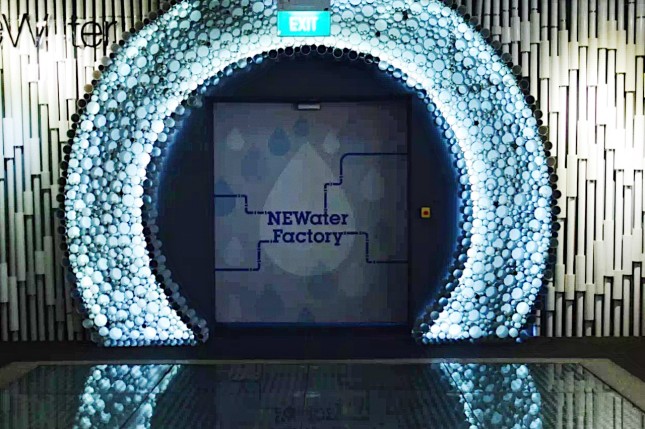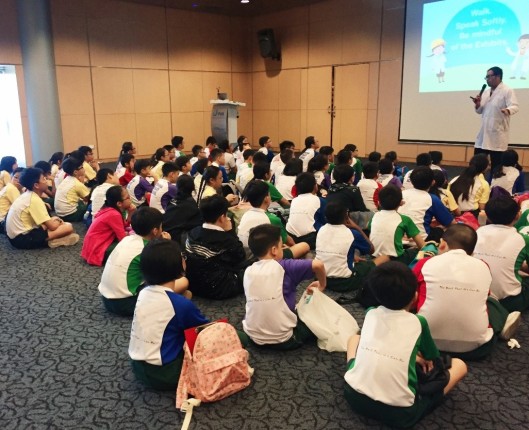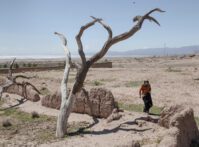-
Can Singapore’s NEWater Spark a Wastewater Revolution in China?
March 12, 2020 By Ailing J. Bressman
China is one of the “thirstiest” countries in the world with a per capita water availability a quarter of the United States. With population, pollution, and water shortages growing unabatedly, reclaimed water (e.g., treating wastewater to drinking water standards) could be the answer to China’s water insecurity. In China, extensive research in the 1980s into water reclamation and urban investments supporting infrastructure in the 2000s sparked production capacity in the country to rise from 63 billion gallons a day to 236 billion gallons per day between 2009 to 2015. Today, however, reclaimed water is a mere drop in the bucket meeting less than 1 percent of total urban water use. China could look to the tiny Southeast Asian city-state of Singapore to learn how it tapped reclaimed water to turn its water-scarce tiny island into a high-tech hydrohub.
A High-Tech Hydrohub
As one of the world’s most densely populated small countries, Singapore squeezes 5.7 million people into 278 square miles—an island about the same size as Chicago with twice the population and no natural aquifers. Since its independence from Malaysia in 1965, the Singaporean government has devised an innovative approach to securing a reliable water supply called the “Four National Taps,” in which the city-state:
Tap 1: Imports 50 percent of its water from neighboring Johor, Malaysia at a low price, but must pay heavily to treat it.
Tap 2: Produces reclaimed wastewater, dubbed NEWater, satisfying up to 40 percent of Singapore’s current water demand.
Tap 3: Desalinates water that could satisfy up to 25 percent of Singapore’s water demand but is not a favored source due to the high costs to run the energy-intensive technology.
Tap 4: Catches storm water in reservoirs to make up the gaps left by the other three.
NEWater is the heart of Singapore’s water sustainability plan and is projected to meet up to 55 percent of the city’s water needs by 2060, relieving the dependence on water imports from Malaysia. While the thought of drinking wastewater from the tap can alarm consumers, Singapore’s advanced wastewater recycling exceeds U.S. EPA and WHO water quality guidelines. NEWater offers a promising water security solution for China and other water insecure countries if they adopt not only just the technology, but also the three pillars that have made it a success in Singapore:
Strong Political Will: In its quest for waste security, Lee Kuan Yew, Singapore’s first prime minister and founding father, stated that “every other policy has to bend at the knees for our water survival.” In 1972, when America was shaping the Clean Water Act, Lee Kuan Yew oversaw the launch of Singapore’s Water Master Plan, the blueprint for the city’s water resource development and water reuse. Singapore became one of the few countries in the world with a dedicated water department in 2001, called the Public Utilities Board (PUB). PUB was instrumental in facilitating the implementation and expansion of the critical NEWater system.
Private Partnerships and Public Engagement: In 2003, when PUB awarded a contract for a desalination plant, it opted to use a public-private partnership (PPP) in which a private company constructs and then operates the project. The efficiency and cost-saving in the desalination plant led the Public Utilities Board to also use a PPP to contract its fourth NEWater plant in 2005 to the company Keppel Seghers, which claims the plant has the capacity to produce up to a third of the city’s NEWater supply.

Public buy-in matters, too. Thus, PUB created the futuristic NEWater Visitor Center, to serve as the focal point for community engagement and educational talks and activities for students and grassroots organizations throughout Singapore. The Singapore government also has arranged for members of their media to visit overseas water recycling projects and local plants for demonstration. The Singapore Every Drop Counts website notably features engaging videos and even a graphic novel about the 4 Taps and NEWater.
Quality Assurance: With lives at stake, there is little room for error. Therefore, NEWater uses a multi-safety barrier approach to ensure quality through:
- Source control. Singapore implemented controls on the disposal of hazardous substances and does routine scientific testing to detect water contamination upstream.
- Comprehensive wastewater treatment. NEWater plants use state-of-the-art reverse osmosis filtration membranes to treat the wastewater and constantly check the water quality to verify system operation. Finally, the treated wastewater is stored in reservoirs to provide time for natural processes to further reclaim the water.
- Internal and external audits. Audit panels, of local and overseas experts, regularly review plant performance and water quality data from source to faucet, and everything in between.
U.S. Toilet-to-Tap Lessons
While not as extensive as in Singapore, today about 4 million U.S. residents in Atlanta, El Paso, Dallas, Southern California, and Northern Virginia get some of their drinking water from treated sewage. To overcome the “yuck factor” and build trust among their customers, water systems invest in public information campaigns. Treatment plants must also be prepared to cut off the tap if a new contaminant sneaks through the multiple layers of treatment and quality control. This happened in the Orange County Water District when an emerging contaminant, NDMA, found its way into the recycled water. Rather than settle for a statement that NDMA is not regulated, the water district worked to eliminate the contaminant. They were rewarded for their efforts with two awards for leadership and innovation in water reuse. Cities have tapped reclaimed water to deal with drought, but need to be careful not to create other problems. For example, diverting treated wastewater back into the drinking water systems can rob streams, wildlife and downstream users of the water that they depend on.
China Reaching a Watershed Moment
Over the past twenty years, Chinese cities have significantly increased wastewater treatment. Moreover, since 2018 the national government’s one-two punch of streamlining water governance responsibilities and passing the comprehensive Water Ten Plan have strengthened water pollution control efforts. Nevertheless, many Chinese cities are still water stressed and struggle to keep up with growing populations. Furthermore, only 10 percent of wastewater was reclaimed in 2014.
Asian water expert Asit K. Biswas notes that strong and well-coordinated water governance and polices were key to NEWater’s success. Thus, Beijing and other large Chinese cities could close the water gap following Singapore’s model if they can get the supporting policies and education outreach right.
Removing all of the pollutants from wastewater to make it safe to drink, however, requires high technology, trained operators, and regulatory oversight, not to mention the energy-intensive high-pressure pumps to push water through the membranes. While China’s mega-cities have the resources to build and run this infrastructure, smaller cities and rural areas do not. “Care must be taken to match the water management capacity with the needs of the country,” says Dr. Karen Mancl, Water Specialist at The Ohio State University. “Smaller cities and rural China can begin with using low technology lagoon systems to treat and disinfect wastewater before reuse for irrigation or industrial uses as they build the capacity to handle water scarcity.”
Ailing J. Bressman was a Project Engineer for a water infrastructure company in China, and recently moved to the USA; she received a Master of Science in Environmental Engineering from the National University of Singapore, where she also coordinated outreach efforts on behalf of the Singapore Public Utilities Board and National Environment Agency.
Sources: Asia and the Pacific Policy Society, Channel News Asia, China Water Risk, Conservation International, Frontiers in Ecology and the Environment, International Journal of Water Resources Development, Journal of Environmental Sciences, Journal of Water Use and Desalination, Keppel Seghers, Legatum Prosperity Index, Orange County Water District, Singapore Ministry of Finance, Singapore National Water Agency, Reuters, Wall Street Journal, Water Supply, and World Bank.
Lead image courtesy of the author.
 A Publication of the Stimson Center.
A Publication of the Stimson Center.









